 Museum
Museum  |
Bomber Command
|
Aircrew Chronicles
|
Aircrew Losses
|
Nose Art
|
BCATP
|
Lancaster
|
Media
|
Bomber Command
|
Aircrew Chronicles
|
Aircrew Losses
|
Nose Art
|
BCATP
|
Lancaster
|
Media
 Museum
Museum  |
Bomber Command
|
Aircrew Chronicles
|
Aircrew Losses
|
Nose Art
|
BCATP
|
Lancaster
|
Media
|
Bomber Command
|
Aircrew Chronicles
|
Aircrew Losses
|
Nose Art
|
BCATP
|
Lancaster
|
Media
Bomber Command Museum Archived Newsletters
Featuring a "Poppy Drop" with one poppy for each
of the Ten Thousand Canadian Bomber Command Aircrew who were killed
NANTON LANCASTER AIR MUSEUM
Nanton, Alberta
September 4th, 1999; 2:00 p.m.
|
Bob Evans, and John Green, NLS flight director, visited Blair Towill's home and workshop on April 9, 1999, to see the nearly completed frames and discuss details of the final finishing. They were advised of all the steps involved with this project. The photos accompanying this article do not do justice to Blair's excellent workmanship. The Society's good friend and member George Ryning of the Aero Space museum in Calgary, supplied the drawings for both the Lancaster rear canopy frame and the forms on which the cockpit canopy frames were built. All in all, a very exacting job, well executed!! Our Grateful THANKS to Blair Towill for this great boost towards completing the Lanc canopy and to George Ryning for his very special aid with the project. Restoration work on the Lanc will get another boost in June when Paul and Peter Whitfield, Sarnia, Ontario, and Larry Wright, Calgary, Alberta, get together with British AME, Ian Hicklan, to work toward eventual start-up of FM-159's four Merlin engines. They will also install the rear cabin canopy and its perspex. Larry Wright has spent several Saturdays during the winter working in the cockpit of the Lanc in preparation for the June work. In regard to the eventual running of the Merlins, an estimated $30,000 is needed to expand the present door size to 110 feet, which will enable the Lanc to be rolled out for the engine start-ups. Funding for this may become a priority in the next year or so. |
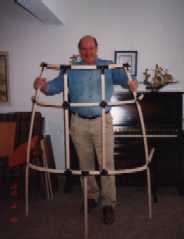 Blair Towill and the Lanc canopy frame. |
|
Our expanded main gallery now features a partial display honouring the aircraft in which most of #6 Group's operations were flown, the Handley
Page Halifax. The centrepiece of this display will be a Halifax propeller blade excavated from a crash site in Belgium. Larry Motiuk of the 426 Squadron Association, Karl Kjarsgaard, and Jay Hammond have all been instrumental in making this artifact available to our museum. Featured as well will be nose art painted on original skin from the Halifax bomber being restored at the RCAF Museum at Trenton, Ontario. This reproduction is courtesy of Clarence Simonsen, nose art researcher and artist. As well, various paintings, photographs, and written information regarding the Lancaster's worthy wartime partner, the Halifax bomber, will be part of the display. Your Society hopes to have the personalities mentioned above, on hand when the display is officially opened later in the summer. Note: The HALIFAX display will be officially opened on June 19, 1999 at 1:30 p.m. |
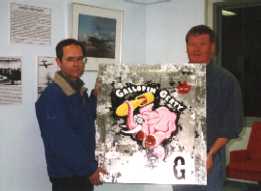 Dave Birrell accepts Halifax nose art from artist and "nose art" researcher Clarence Simonsen. |
Lanc FM-159's navigator table has been restored over the winter by Andy Lockhart, Calgary, Alberta. Andy brought the completed table back in early April after spending several weeks restoring the table frame and remaking the top with its hinged storage opening. The table will likely be installed in the Lancaster's cabin area in June when Larry Wright, Paul and Peter Whitfield, along with UK AME Ian Hicklan, are slated to arrive for a two week work session on the Lanc. Our Society extends its grateful THANKS to Andy Lockhart for his help with this project. |
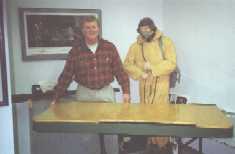 Andy Lockhart restored the Lancaster's navigator's table. |
|
Members will be familiar with our plaque boards which list those who have assisted with the development of the museum. As of April 24/99 there are 1115 plaques on display listing the names and home towns of contributors. Some also indicate that the donation was made in memory of a particular individual. A few moments spent perusing these boards demonstrates to our visitors the broadly based support our museum enjoys together with some touching references to friends and relatives. One of the priorities in planning for our new display area was to enable the plaques to be displayed at eye level. In the past, our lack of space resulted in placing the display boards one above the other. Many of our members mentioned this made both the ones at the top and bottom difficult to read. This problem has now been solved and the plaque boards are now grouped attractively and efficiently at eye level. If you are in the museum and looking for a particular plaque please check at the front desk for assistance. An alphabetical listing of all the names and the location of the plaques is available. For information about the plaques that represent the Society's "Square Footer Club," "Lifetime Membership," and "Wing Commanders Club," please call the museum at (403) 646-2270. |
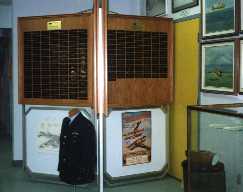 The plaque boards newly displayed. |
|
The rudder frame, which was restored by Bill Erickson of Claresholm, is now in the hands of one of our former SAIT students, Greg Morrison. He is going to complete the restoration and apply the fabric. Greg works as an Aviation Mechanical Engineer for High River Aviation Services, High River, AB, and has been volunteering once a week in the museum shop. We will be hiring two SAIT first year AME students for the summer under a Federal Government Student Employment Grant just approved. Renewing the damaged aluminium skin on both the fuselage and wings of the Blenheim will be their main job for the summer. ANYONE having spare Bolingbroke propeller parts (in any condition), as just mentioned in this article, please contact us. Your assistance would be very much appreciated! |
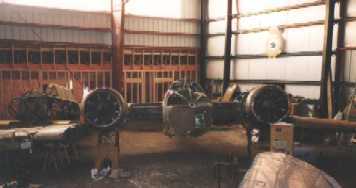 The 2000 Project - Bristol Blenheim IV. |
Steve Dixon of Brant, Alberta, holds a framed selection of photographs of the Lancasters stored at the Claresholm BCATP base after the war. The original photos were taken by Steve in 1947. This photo montage is now on display in the museum. The society extends a Grateful THANKS ot Steve and Helen Dixon for this donation to the museum. |
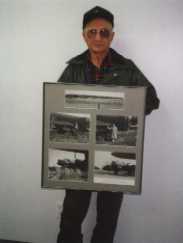
|